Integrating Worms into Your Compost Bin for Better Soil
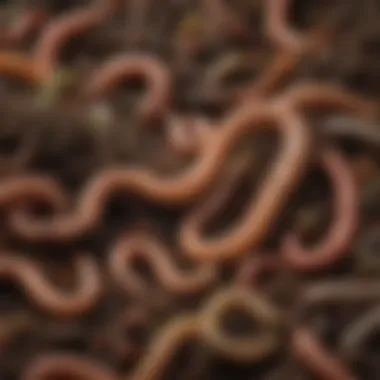
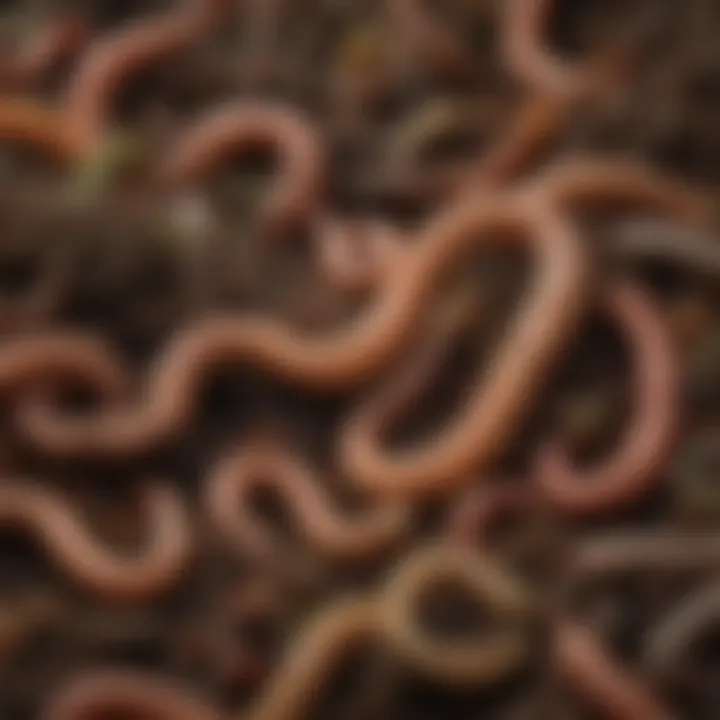
Intro
Composting has certainly made a comeback in recent years. It's not just about tossing kitchen scraps into a bin anymore; it's a fine art that can be honed with the addition of worms. Vermicomposting, as it is called, is the practice of using worms to break down organic material; it’s like having little workers in your compost bin that chomp through waste and churn out nutrient-rich fertilizer. But why do this? The benefits can be profound for both the environment and the health of your garden.
Overview of the Topic
Definition and Importance
Vermicomposting is essentially a method of composting that utilizes particular species of worms, such as the red wigglers, to convert organic waste into valuable compost. These worms not only speed up the composting process but also add essential nutrients back into the soil. In an age where sustainability is key, integrating worms into your compost system is not just a trend; it’s a necessary practice for promoting soil health.
Current Trends
The use of worms in composting isn’t limited to backyard gardeners. It’s gaining traction among urban gardeners, farmers, and enthusiasts looking to yield healthier crops while minimizing their ecological footprint. Communities are starting to embrace vermicomposting workshops, where they learn how to manage a worm colony efficiently, highlighting the ongoing shift toward environmentally friendly agricultural practices.
Key Techniques and Practices
Step-by-Step Guide
Creating a worm-friendly compost bin involves a few straightforward steps:
- Choose the Right Worms: Red wigglers are best suited for composting. They thrive in decomposing organic matter and are excellent for breaking it down.
- Set Up Your Bin: A bin can be as simple as a plastic tub with holes drilled for ventilation. Ideally, your compost bin should be around 2 feet by 3 feet.
- Create a Bedding Layer: Shredded newspaper, cardboard, or coconut coir makes excellent bedding. The bedding should be damp but not soaking wet.
- Feed the Worms: Start adding scraps like vegetable peels, coffee grounds, and eggshells. Avoid meat, dairy, and oily foods as they can attract pests.
- Maintain Conditions: Worms are sensitive to extreme temperatures. Keep their bin in a temperate environment and ensure moisture levels are consistent.
- Harvest Compost: After about 2-3 months, you’ll notice rich, dark soil. You can sift this from the worms, or let them migrate to a new area of the bin with fresh food to make harvesting easier.
Tools and Equipment Needed
Before diving into vermicomposting, think about what you'll need:
- Compost bin (plastic or wooden)
- Bedding materials (shredded paper, cardboard, etc.)
- Kitchen scraps (vegetable peels, coffee grounds)
- Watering can (to maintain moisture)
- Hand trowel (for mixing and harvesting compost)
Challenges and Solutions
Common Obstacles
Not everything will run smoothly, though. Here are some common challenges:
- Odor Issues: If you notice a foul smell, it’s often caused by overfeeding or adding unsuitable materials to the bin.
- Pests: Fruit flies and other pests might invade your compost bin if kept open.
- Worm Migration: Sometimes, worms can escape the bin looking for better conditions.
Innovative Solutions
However, there are ways to mitigate these issues:
- Monitor Feeding: Feed worms small amounts gradually rather than large quantities at once.
- Cover the Bin: Using a lid or cover can prevent pests and keep the environment stable.
- Use proper ventilation: Ensure your bin has enough air flow to keep it healthy and to prevent any unwanted migrations.
"Healthy soil is the foundation of sustainable agriculture."
In summary, integrating worms into your compost bin is more than just a helpful trick; it’s a significant investment in your gardening future. This practice not only improves soil health but also fosters a sustainable approach to managing organic waste, aligning perfectly with ecological goals. As the movement towards environmentally conscious living grows, understanding the nuances of vermicomposting becomes increasingly essential for any agricultural enthusiast.
Understanding Vermicomposting
Vermicomposting represents a fascinating intersection of biology and agriculture, where earthworms grace our compost bins with their presence, transforming organic waste into nutrient-rich soil conditioner. This process not only promotes efficient waste management but also enhances the fertility of the soil, a vital aspect for any farmer or gardening enthusiast. Within this section, we will explore the essential elements of vermicomposting and shed light on why it holds significant value in both ecological and agricultural contexts.
Definition and Importance
Vermicomposting refers to the method of using earthworms to break down organic waste and produce vermicompost, a high-quality fertilizer. This technique is notable for its efficiency and effectiveness. Unlike traditional composting methods that can take several months, vermicomposting can yield finished compost in as little as eight weeks.
The importance of vermicomposting lies in its ability to recycle kitchen scraps, yard waste, and other biodegradable materials into a valuable resource. As the saying goes, one person’s trash is another person’s treasure. In this case, your discarded food scraps can transform into a potent growth booster for plants. Better yet, it helps reduce landfill waste, which contributes to both environmental sustainability and a decrease in greenhouse gas emissions.
The Role of Worms in Composting
Worms, particularly species like Eisenia fetida, commonly known as red wigglers, play a pivotal role in the composting process. These creatures consume organic matter, which passes through their digestive systems and undergoes a remarkable transformation. During digestion, the microbes in their gut break down the food, resulting in worm castings – the end product of vermicomposting.
What makes worm castings so special? They’re packed with nutrients and have a unique structure that promotes healthy plant growth. Not only do they contain essential nutrients such as nitrogen, phosphorus, and potassium, but they also hold beneficial microorganisms that can enhance soil health.
"Worm castings can improve nutrient availability and enhance soil aeration, which helps root development."
In simpler terms, these tiny creatures do a whole lot more than just munch on your kitchen waste. They actively participate in enriching the soil, fostering a thriving ecosystem that benefits plants and gardeners alike.
In summary, understanding vermicomposting not just opens up a method for waste reduction but also aligns with sustainable agricultural practices, allowing for improved soil health and reduced reliance on synthetic fertilizers. This sets the stage for more fruitful discussions on choosing the right worms and setting up an effective vermicomposting system.
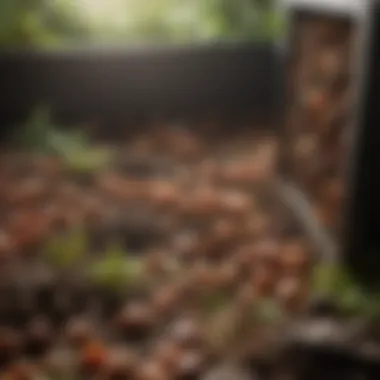

Types of Composting Worms
When delving into the world of vermicomposting, understanding the different types of worms most commonly used is crucial. This section not only illuminates the significance of selecting the right worms but also reveals how their unique traits can influence your composting outcomes. The right choice can make the difference between a thriving compost system and an ineffective one.
Common Species for Composting
A key player in successful composting is knowing which species of worms are best suited for the task. Among the most popular worms are the Red Wigglers, European Nightcrawlers, and Tigers Worms.
- Red Wigglers (Eisenia fetida): These little champions are the most favored for composting. They flourish in organic waste and are adept at consuming large amounts of food scraps. If you’re looking for a worm that’s quick on the uptake, Red Wigglers are your best bet!
- European Nightcrawlers (Eisenia hortensis): Slightly larger than their red counterparts, these worms can be quite good for composting as well. They not only eat organic materials but can also burrow deeper, enhancing aeration and drainage in your compost pile.
- Tiger Worms (Eisenia veneta): With a distinct striped appearance, Tiger Worms are keen to break down vegetative matter. They thrive in environments rich in organic content, making them a great asset for composters seeking biodiversity in their bins.
Choosing the right species of worm hinges on the specific composting conditions available to you as well as what you intend to achieve. Each of these species plays a role in enhancing nutrient cycling and breaking down organic matter, yet they do so in unique ways.
Selecting the Right Worms
Knowing the species is half the battle; selecting the right worms for your compost bin involves more than just picking a name from a hat. Consider the following elements when making your choice:
- Temperature Tolerance: Different species have varying tolerances for temperature. Red Wigglers, for instance, are more adaptable to typical composting conditions, while European Nightcrawlers can withstand cooler situations.
- Waste Composition: The types of kitchen and garden waste you plan to add can influence your worm choice. For instance, if you frequently compost citrus scraps or cantaloupe rinds, some species might perform better than others.
- Activity Level: Different worms consume food at varying rates. Red Wigglers are voracious eaters, while Nightcrawlers tend to be more leisurely. If you want a compost system that breaks down matter quickly, lean towards the more active species.
- Local Availability: Sometimes, your choice is limited by what's available in your local area. Many gardening or farming supply stores stock these worms, so ensure that they’re fresh and healthy before making a purchase.
"Choosing the right worms is not just about preference; it's about ensuring a harmonious balance in your compost ecosystem.”
Taking the time to research and select the correct species can provide a solid foundation for your composting journey. In turn, this can ensure you're investing your effort in a system that yields rich vermicompost, beneficial for your garden or farm.
By understanding the types of composting worms and carefully selecting the right ones for your needs, you can effectively enhance your composting process and contribute greatly to soil health.
Benefits of Worms in Composting
Integrating worms into your compost bin can elevate the composting process into something remarkable. These little creatures do more than wriggle around; they serve as efficient recyclers of organic waste, playing a crucial role in transforming food scraps into nutrient-rich compost. Understanding the specific benefits that worms bring to composting can help farmers and enthusiasts alike optimize their compost systems, leading to healthier soil and thriving crops.
Enhanced Nutrient Cycling
When worms are introduced to a compost environment, they significantly boost nutrient cycling. As they consume organic material, they break it down into smaller particles, which increases the surface area for microbial activity. This activity leads to the rapid release of vital nutrients like nitrogen, phosphorus, and potassium.
- Nutrient Availability: Worms excrete these nutrients in forms that are easily understandable and accessible to plants. Vermicompost, the end product of their digestive process, is packed with beneficial microorganisms. This helps to promote plant growth by making nutrients readily available in a slow-release fashion.
- Carbon-Nitrogen Ratio: Worms help balance the carbon to nitrogen ratio in the compost. They preferentially feed on materials that may have a high carbon-to-nitrogen ratio, breaking down tough materials like leaves or cardboard. This leads to a more stable compost that retains moisture and nutrients more effectively.
Improved Soil Structure
Worm castings, commonly referred to as vermicast, are a game-changer for soil health. These castings, which are compacted piles of digested organic matter, improve the structure of soil dramatically.
- Aeration and Drainage: The presence of worms creates channels in the soil that enhance aeration. This aeration allows roots to develop properly while ensuring that water drains effectively, preventing waterlogging that can damage plant roots.
- Soil Aggregation: Worm castings bind soil particles together, which leads to a crumbly texture. This texture is not only conducive to root penetration but also supports beneficial microorganisms that assist in nutrient uptake by plants.
Accelerated Decomposition
The speed at which organic matter decomposes can make a world of difference in a composting system. Worms are like little composting factories. They accelerate this decomposition process due to their unique feeding habits and biological processes.
- Increased Microbial Activity: As worms ingest organic waste, they also consume microorganisms that break down this material. Their digestive systems create an ideal environment for microbes, promoting a thriving community of bacteria, fungi, and protozoa that continue breaking down organic matter even after the worms move on to their next snack.
- Faster Composting Cycles: With worms in the mix, you can expect a faster turnover of compost. What might take several months can be reduced to weeks when worms are actively breaking down waste. This rapid conversion not only means more compost for your garden but also less waste going to landfills.
"Integrating worms into composting not only nourishes the soil but also ensures a sustainable practice that can help address food security challenges."
Setting Up a Vermicomposting System
Setting up a vermicomposting system is crucial—it’s the backbone of integrating worms into your composting efforts. Think of this as laying down a solid foundation for a house. If the base is strong, the entire structure stands tall and serves its purpose well. This is where all the magic happens; the worms don’t just sit around; they work tirelessly to recycle organic waste into nutrient-rich compost.
When you're ready to plunge into this venture, keeping a few key considerations in mind can make all the difference. First off, the size and type of the bin you choose directly affects worm health and, ultimately, the quality of your compost. A well-structured system can prevent the dreaded odors and keep the environment inviting for your wriggly helpers. The benefits here are two-fold: you create an efficient recycling mechanism for your kitchen scraps, and you produce a soil amendment bursting with nutrients.
Choosing the Right Bin
The selection of a compost bin for vermicomposting can be likened to picking the right pair of shoes for a marathon. They need to fit just right and be suitable for the terrain. You want a bin that can hold your worms comfortably while allowing for adequate airflow. The usual suspects are plastic bins, wooden boxes, or even repurposed items like old baths.
When it comes to ventilation, it shouldn’t be an afterthought. Small air holes are essential—they help maintain an oxygen-rich environment. As for size, it varies depending on your composting aspirations. If you’re only dealing with a few scraps, a small bin would suffice. For larger households, consider a larger bin that holds more material, as worms require space to thrive and do their magic.
Optimal Bedding Materials
Choosing the right bedding is like setting up a cozy home for your worms. They thrive in a comfortable environment that promotes health. Bedding materials create a habitat that retains moisture and facilitates microbial activity—both vital for worm health. Materials such as shredded newspaper, cardboard, and coconut coir are all good bets. Avoid glossier paper as it’s not biodegradable and can harm your worms.
Remember—it might seem trivial, but the quality of bedding greatly impacts composting efficiency. A good rule of thumb is to create a bedding layer of about six inches at the bottom of your bin. This gives your worms plenty of material to maneuver through. Additionally, mixing in some food scraps with the bedding can kickstart the microbial activity, feeding the worms right from the get-go.
Maintaining Moisture Levels
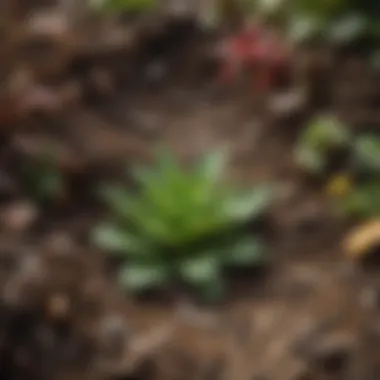

Moisture is another critical piece of the vermicomposting puzzle. Think of it like a tightrope walk—too much moisture creates a swampy environment that’s less than ideal for worms, while too little leads to dryness that can stress them out. The goal is to achieve a moisture level similar to that of a damp sponge.
To gauge moisture, you can take a handful of the material and squeeze it. If it drips with water, it’s too wet; if it crumbles easily, it’s too dry. Maintaining that moisture balance ensures that your worms can navigate through the content comfortably while effectively breaking down organic matter.
"A well-set vermicomposting system transforms mundane kitchen scraps into a gardener's gold, enriching soil health and promoting sustainable practices."
Feeding Your Composting Worms
The well-being of your composting worms hinges significantly on their diet. Just like humans and other creatures, worms thrive on a nutritious menu that supports their needs during the composting process. By understanding what to feed your worms and what to avoid, you can optimize their health and efficiency. A balanced diet not only boosts the composting process but also ensures that the end product—vermicompost—is rich in nutrients and beneficial microorganisms.
The right food choices stimulate worms to break down organic material effectively, enhance microbial activity, and create a thriving ecosystem within the bin. Yet, this task involves some careful consideration of both the kinds of food and the quantity you provide.
Food Choices and Restrictions
Selecting the right comestibles for your composting worms is akin to choosing ingredients for a gourmet dish. Certain foods are like a feast, while others might be downright harmful. Here’s a rundown of what you should toss in and what to keep out:
Beneficial Foods:
- Fruits and Vegetables: Worms adore kitchen scraps like banana peels, apple cores, and carrot tops. But ensure they're chopped up; smaller pieces break down quicker!
- Coffee Grounds: A favorite among many composters, used coffee grounds contribute to a nitrogen-rich diet.
- Eggshells: These not only serve as a calcium supplement but also promote grit, which is essential for digestion.
- Yard Waste: Shredded leaves and grass clippings can add to the fiber content of your worm food.
Foods to Avoid:
- Meat and Dairy Products: These items can cause odors and attract pests, turning your compost bin into a banquet for unwanted guests.
- Citrus Fruits: While a small amount might be okay, too many sour pieces can overwhelm your worms and stunt their growth.
- Processed Foods: Packaged snacks and leftovers might have additives that could be harmful to your worms.
Important Note: Always introduce new food gradually and monitor how your worms react. If things seem off, reconsider your offerings!
Creating a Balanced Diet
Crafting a balanced diet for your worms doesn’t require a culinary degree, but a little bit of thought goes a long way. We all know you can't live on chocolate alone—worms need variety too! To keep your worms healthy and productive, focus on combining carbonaceous and nitrogen-rich materials:
- Carbon Sources (Browns): These are like the bread of your worms’ diet. Options include dried leaves, straw, or shredded newspaper.
- Nitrogen Sources (Greens): Think of greens as the butter on that bread—essential and delicious! This category includes leafy vegetable scraps or coffee grounds.
When you aim for a good balance, a general rule of thumb is to maintain a carbon-to-nitrogen ratio of about 30:1. Achieving this balance helps prevent unpleasant odors in your compost bin. Moreover, it ensures that your composting worms aren’t overloaded with one type of food type, which can lead to health issues.
Troubleshooting Common Issues
Integrating worms into your compost bin can significantly enhance the decomposition process, but like any living system, it can face a few bumps along the road. Addressing common issues is crucial, as it saves time and resources, ensuring the worms thrive and the compost remains effective. Keeping an eye out for potential problems is important for those who wish to maintain a harmonious balance in their vermicomposting efforts. Let’s take a closer look at some prevalent issues and strategies for overcoming them.
Identifying Unpleasant Odors
One of the most common challenges in vermicomposting is dealing with unpleasant odors. While the intention is to create a rich, organic compost, a bad smell can suggest that things are out of whack in the bin. No one wants to experience a horrific scent wafting through the backyard or kitchen!
Here are a few signs and pointers to consider:
- What causes the stink? Usually, it relates to an overabundance of food scraps, especially those that are high in nitrogen, like fruit peels, or if there’s too much moisture.
- Active Monitoring: It’s good practice to regularly check your bin, observing both its odor and its visual condition. If you start noticing a funky smell, it’s time to intervene.
- Solutions: To fix the issue, consider reducing the amount of kitchen scraps you're adding, mixing in dry materials like shredded newspaper or cardboard, which can help balance the moisture and odor. A sprinkle of lime can also help neutralize unwanted odors.
"
Harvesting Vermicompost
Harvesting vermicompost is a critical step in the vermicomposting process, marking the transition from a nutrient-rich substrate teeming with beneficial organisms to an invaluable amendment for soil health. Properly executed, this phase elevates not just your composting game but also enhances your gardening or farming pursuits. As worms work tirelessly through kitchen scraps and yard waste, they transform them into a dark, crumbly substance that you can practically sprinkle like fairy dust on your plants.
Signs of Maturity
Identifying the right moment for harvesting is key to maximizing the benefits of vermicompost. Generally, mature vermicompost is dark, has an earthy smell, and resembles fine soil. You might notice it has a grainy texture, free of recognizable scraps of food. Worm castings, the product of the decomposition process, will be abundant, and your compost bin should have a distinct, rich aroma rather than a sour one. Here are a few signs to look for:
- Texture and Appearance: The castings should be dark and crumbly, appearing smooth and soft.
- Odor: A pleasant earthy scent is a good hint; any foul odors likely indicate unnecessary decomposition.
- Worm Activity: As maturity approaches, the population of adult worms may decrease as they age or leave the bin, indicating they’ve done their job.
Understanding these signs ensures you're collecting vermicompost at its peak, ready to give your soil a healthy boost.
Methods for Harvesting
Once you've determined that your vermicompost has matured, the next step is to harvest it. There are several effective methods for doing so, depending on your available space and resources. Each method has its own perks and quirks:
- The Light Method: This strategy involves using light to drive the worms down while you scoop out the compost on top. Worms are sensitive to light, so they begin to burrow deeper away from the bright exposure. You can use a simple floodlight or a flashlight. Give it about 30 minutes, then gently take off the top layer of compost.
- The Separation Method: This one's straightforward and effective. Prepare a new bin and add fresh bedding. Start adding fresh food scraps to this new bin while leaving the old worms to finish their work. Over time, the worms will migrate to the new bedding, and you can then harvest the finished vermicompost.
- The Sifting Method: By using a sieve or specialized compost sifter, you can separate worms from vermicompost quickly. Simply screen out the castings, and what’s left will be your worms or larger organic matter that still needs composting.
- Tipping and Dumping: In a more hands-on approach, you can pour the bin contents onto a tarp or surface. Give the mixture a shake. The worms tend to work their way down to the bottom, allowing you to harvest the dark compost from the top.
"The treasure of rich, dark vermicompost is waiting for you; just follow the signs and methods to bring it into your garden's embrace."
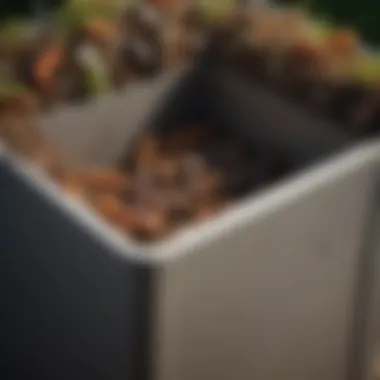
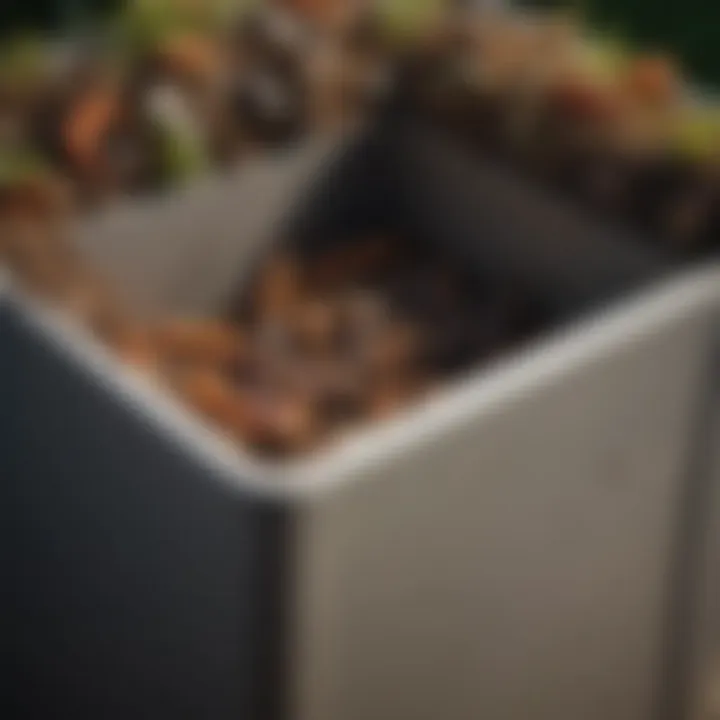
Selecting the right method to harvest can make a significant difference in ease and efficiency. Each has its own nuances but ultimately leads you to unlock the full potential of your compost bin. Proper harvesting ensures that your garden receives the nutrient boost it craves, promoting sustainable growth and resilience in your plant life.
Utilizing Vermicompost in Agriculture
Integrating vermicompost into sustainable agriculture has gathered momentum over recent years. It is drawing interest not only for its effectiveness but also for its simplicity in execution. Farmers and enthusiasts alike are recognizing how beneficial it can be when it comes to enriching soil structure, promoting healthy crops, and ultimately improving yields. Vermicompost, which is worm-cast compost, can furnish nutrients in a form that plants can readily uptake while also enhancing microbial activity in the soil. As awareness grows, this segment seeks to clarify practical aspects of using vermicompost, looking at its application techniques and its many benefits for crop health.
Application Techniques
When it comes to using vermicompost, the techniques can vary based on the scale of agricultural practices, as well as the type of crops being cultivated. Here are some common methods for applying vermicompost:
- Top Dressing: This is a simple way to apply vermicompost by spreading it over the soil's surface. It’s particularly effective for potted plants or during the growing season when crops can utilize the nutrients right from the soil surface.
- Soil Mixing: For new garden beds or planting areas, mix vermicompost into the soil before planting. This ensures a nutrient-rich environment for the roots as they establish.
- Liquid Fertilizer: Creating a vermicompost tea by steeping vermicompost in water offers a nutrient-dense liquid that can be watered on plants or used as a foliar spray. This method allows for quick absorption of nutrients.
- Row Application: When planting seeds or seedlings, placing a band of vermicompost in the seed furrow or around the roots can significantly benefit young plants by giving them a burst of nutrition.
These application techniques create opportunities for farmers to tailor their methods according to the needs of their crops while ensuring that soil health is maintained.
Benefits for Crop Health
Utilizing vermicompost can transform agricultural practices and make substantial differences in crop health. Here are key advantages:
- Nutrient Availability: Vermicompost is rich in essential nutrients like nitrogen, phosphorus, and potassium, alongside micronutrients. This enhances the nutrient profile available to plants, leading to healthier growth.
- Soil Aeration: The structure of vermicompost improves soil aeration and drainage. Good aeration enhances root development and assists with moisture retention which is crucial during dry spells.
- Microbial Activity: Introducing worms into the compost process fosters beneficial microbial activity. These microorganisms assist with decomposing organic matter, thus cycling nutrients faster and making them available to plants.
- Disease Resistance: Some studies have suggested that plants nourished with vermicompost can show increased resistance to diseases and pests. This is likely due to the balanced nutrients and the robust biological activity in the soil.
In summary, utilizing vermicompost not only aids agriculture in producing healthier crops but also aligns closely with sustainability goals. By enriching the land, it helps to create an ecosystem that benefits both the plants and the soil, which is pivotal for future food production.
"The secret to healthy farming is healthy soil. Use vermicompost to breathe new life into your crops."
By understanding and implementing these techniques, farmers can make substantial strides in attaining not just high yields but high-quality produce, all while respecting the environment.
Environmental Implications
Vermicomposting doesn’t just puff up the goodness of your garden; it plays a vital role in shaping sustainable practices and reducing harmful waste. The importance of integrating worms into composting systems extends far beyond mere soil enhancement; it aligns with global efforts to foster environmental sustainability. By understanding how this practice contributes to ecological health, we can better appreciate its relevance in today’s agricultural narrative.
Contribution to Sustainable Practices
Worms serve as natural recyclers. Their presence in the compost bin enhances nutrient cycling, turning kitchen scraps and yard waste into valuable compost rich in minerals and beneficial microbes. The process of vermicomposting contributes significantly to the natural ecosystem by:
- Reducing Chemical Inputs: When compost is enriched by worms, it provides a natural source of nutrients. As a result, farmers can minimize reliance on synthetic fertilizers that can leach into waterways and harm aquatic ecosystems.
- Promoting Biodiversity: Healthy compost boosts soil diversity, which in turn fosters a vibrant ecosystem above and below ground. This diversity helps with pest management and enhances plant resilience.
- Enhancing Soil Health: Worm castings are not just great for plants; they improve soil structure, allowing for better drainage and aeration. This means less erosion and runoff during heavy rains, both serious issues in many agricultural areas.
This contribution to sustainable practices emphasizes that adopting composting techniques with worms can greatly reduce an operation's overall ecological footprint.
Impact on Waste Reduction
Vermicomposting is a powerful method for tackling the mounting waste crisis. Every year, millions of tons of organic waste find their way to landfills, which not only contributes to greenhouse gas emissions but also leads to soil degradation and loss of nutrients. By integrating worms into compost bins, we can achieve:
- Diverting Organic Waste: Worms can effectively process a wide range of organic materials including fruit and vegetable scraps, coffee grounds, and cardboard. Households and farms that utilize worms can significantly cut down their waste output.
- Turning Waste into Resource: Instead of ending up in landfills, organic matter transformed by worms returns vital nutrients to the soil, creating a closed-loop system that promotes sustainable agriculture.
- Encouraging Community Involvement: When individuals participate in vermicomposting, they become more conscientious about their waste habits. Community efforts aimed at reducing landfill contributions can begin at home, amplifying awareness and prompting more sustainable community practices.
"Every worm in your compost bin is a soldier in the fight against waste and ill-prepared soil. By playing our part, we contribute to a more sustainable future."
Through integrating worms into composting systems, we see that vermicomposting not only enriches soil but also substantially contributes to environmental wellbeing. It’s about nurturing the earth while working in harmony with its processes, making it a vital consideration for anyone invested in sustainable practices.
Future of Vermicomposting
The future of vermicomposting is a topic that holds immense significance, especially given the growing awareness of environmental sustainability and the demand for organic farming solutions. The blending of traditional composting with the biological prowess of worms ensures that composting technologies will evolve, integrating vermicomposting practices into the mainstream agricultural narrative. This is not just about creating nutrient-rich soil; it’s about developing a holistic system that benefits the environment in multiple ways.
By understanding the future of vermicomposting, farmers and gardening enthusiasts alike can take significant strides towards sustainable agricultural practices. Here are some key elements that stand to shape this future:
- Increased Awareness of Soil Health: As more farmers realize the pivotal role that soil plays in crop production, vermicomposting will gain traction. Healthy soil leads to better crop yields, thus improving food security.
- Support for Local Economies: Utilizing natural composting methods can lower costs for farmers who currently rely on chemical fertilizers that may not only harm the environment but also drain their resources.
- Educational Initiatives: A greater push for education around the benefits of vermicomposting, especially among younger generations, can facilitate a cultural shift in how we approach waste and soil health.
In light of these considerations, the integration of worms in composting is poised to offer compelling benefits such as enhanced biodiversity, improved nutrient availability, and increased resilience against pests and diseases. Indeed, vermicomposting is more than a method; it’s a pathway towards a greener future.
"Every bit of organic waste you compost with worms is a step towards a healthier planet."
Trends in Agricultural Practices
As the agricultural landscape evolves, the trends in vermicomposting reveal a shift toward more sustainable practices. Farmers are increasingly turning to these techniques to enrich their soil without the drawbacks associated with synthetic fertilizers. Here are some notable trends:
- Regenerative Agriculture: There’s a notable pivot towards regenerative agriculture practices where vermicomposting serves as a cornerstone. This approach emphasizes restoring the health of the soil through natural means.
- Community Gardens: Many urban areas are witnessing a rise in community gardens, emphasizing local production and waste reduction. Vermicomposting fits perfectly into this model, leveraging food scraps to grow fresh produce.
- Micro-farming: The trend of micro-farming is catching on, and for those limited on space, vermicomposting offers an efficient way for small-scale farmers to create high-quality compost in volume.
Innovations in Composting Technology
Innovations are continually reshaping how composting and vermicomposting are approached. Embracing new technologies can streamline the processes and make them more accessible. Here are a couple of noteworthy innovations in the field:
- Smart Compost Bins: With advancements in technology, smart compost bins equipped with sensors are on the rise. These bins can monitor moisture levels, temperature, and even warn you when it’s time to feed your worms.
- Automated Harvesting Solutions: Some companies are working on machines designed for automated harvesting of vermicompost. This could greatly reduce the labor involved and allow even more people to engage in vermicomposting practices.
The future of vermicomposting not only promises an ecological benefit but also positions itself as a pivotal component of modern agriculture, intertwining technology with nature's processes. As society continues to seek balance between productivity and sustainability, the practice of integrating worms into composting will likely remain at the forefront, benefiting both the planet and those who depend on it.



